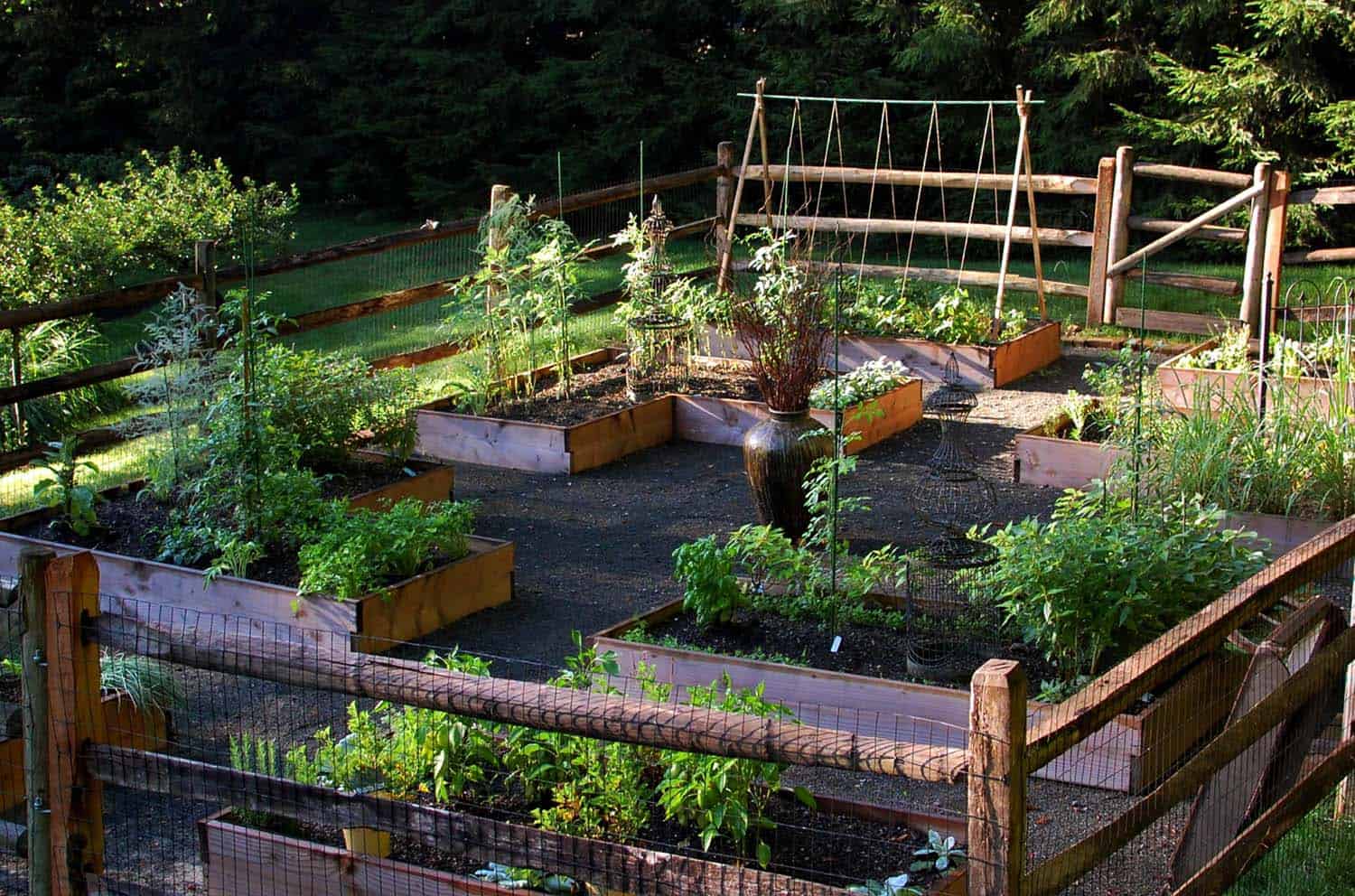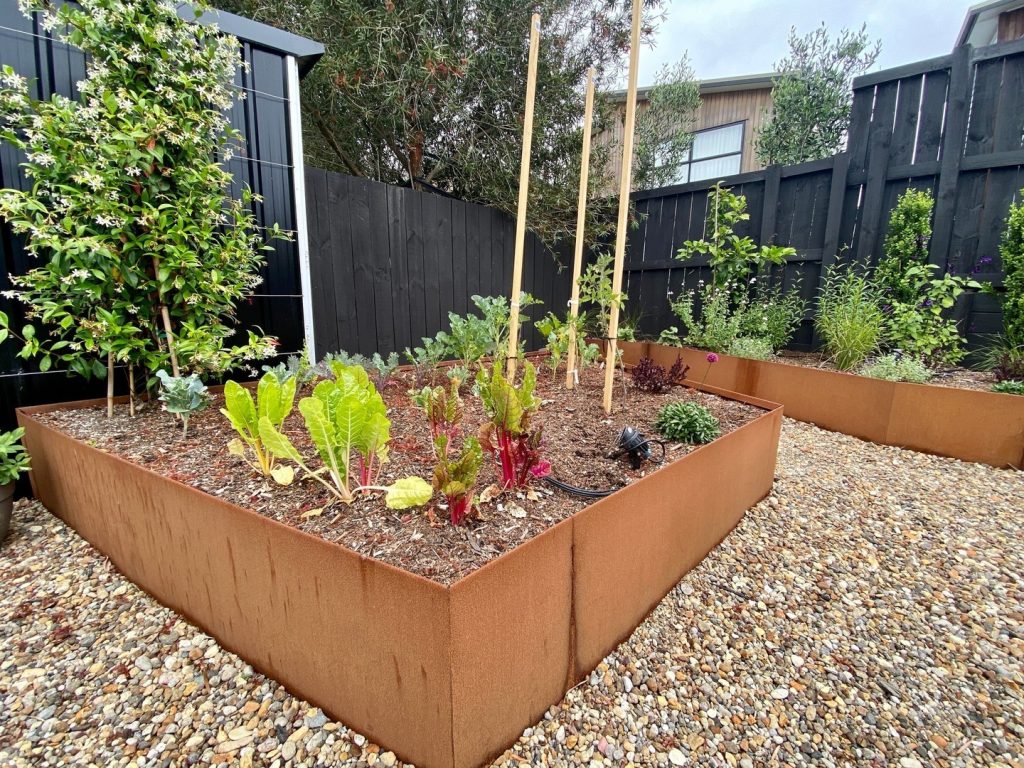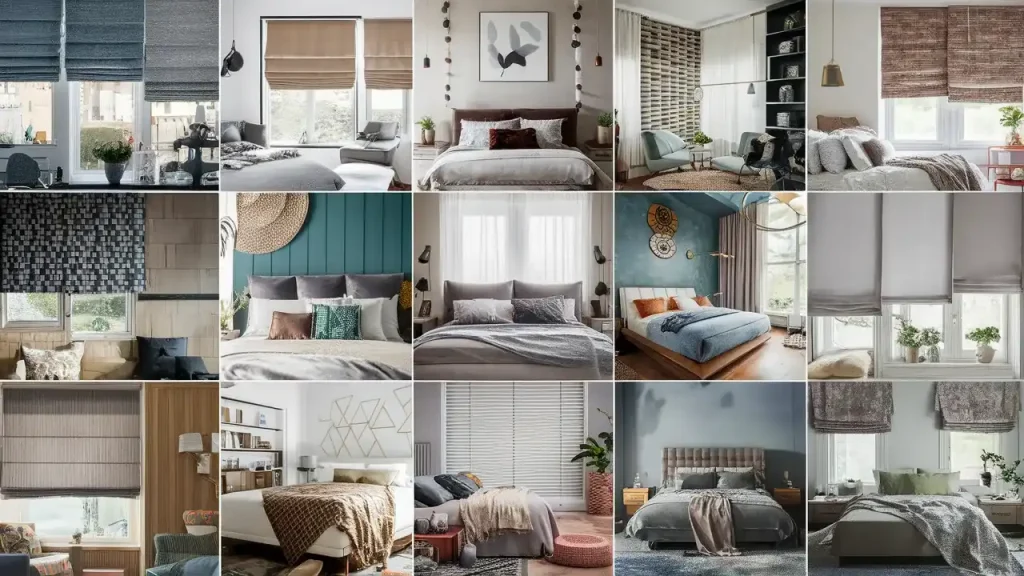Raised garden beds are becoming a popular choice for gardeners across the USA, offering a simple yet effective way to cultivate plants in an organized and aesthetically pleasing manner. They not only add structure and style to your outdoor space but also make gardening more accessible and enjoyable. Whether you’re growing vegetables, herbs, or flowers, the layout of your raised garden beds plays a vital role in maximizing space, improving soil health, and enhancing the overall look of your backyard.
In this article, we’ll explore 19+ creative and inspiring raised garden bed layout ideas, broken down into two parts. Each layout idea is designed to suit a variety of outdoor spaces and gardening preferences, so you’ll find something that fits your style and needs. Let’s dive into the first set of ideas to help you get started on your gardening journey.
1. Traditional Rectangular Layout
The classic rectangular raised garden bed layout is a timeless choice that never goes out of style. This layout is perfect for gardeners who prefer simplicity and functionality. It works well in large or small spaces, providing plenty of room to grow a variety of plants, from vegetables to flowers. The neat rows allow for easy navigation and organization, making it a great option for beginners and seasoned gardeners alike.
This design is especially ideal for those looking to grow row crops like carrots, lettuce, and beans. The straight lines give you the opportunity to plant in a systematic manner, and you can easily adjust the number of beds to suit the available space. Another benefit of this layout is that it maximizes sunlight exposure for each plant, ensuring optimal growth.
For the best results, consider placing these beds in areas with good drainage and plenty of sunlight. Raised garden beds in a rectangular shape can be easily bordered with mulch or decorative stones to add a personal touch to your garden.
2. Square Grid Layout
A square grid layout is an excellent way to organize your raised garden beds while maximizing space. This layout consists of square beds arranged in a grid pattern, making it ideal for creating a highly organized and aesthetically pleasing garden. The grid design allows you to separate different types of plants, making it easier to manage their growth.
Square grid gardens work particularly well for smaller spaces because they make the most of the available area. This layout also facilitates companion planting, as you can pair plants that complement each other in specific sections. For example, you could plant basil alongside tomatoes or marigolds next to beans to help keep pests at bay.
You can choose to create a square grid with beds that are the same size or mix it up by varying the dimensions to create a more dynamic look. Pathways between the squares should be wide enough for easy access, and consider adding a weed barrier beneath each bed to keep unwanted plants from creeping in.
3. Circular Garden Bed Design
A circular garden bed layout is an excellent choice for creating a visually stunning centerpiece in your backyard. Circular beds offer a sense of flow and harmony, transforming your garden into a calming, beautiful retreat. This design can be used for a variety of plants, including flowers, herbs, or even a vegetable garden.
Circular beds are especially suitable for gardens that need a focal point or for those looking to add a touch of creativity to their outdoor spaces. The rounded shape creates a balanced look that works well in both modern and traditional gardens. Additionally, circular garden beds allow for easy access from all sides, making it convenient for gardeners to care for their plants.
If you have a larger backyard, you can even create multiple circular beds and arrange them in a pattern to enhance the visual appeal. For a more formal look, you could place a circular garden bed in the center of a geometric pathway, or opt for a more natural feel by arranging the beds sporadically.
4. U-Shaped Raised Beds
The U-shaped raised bed design is perfect for those who want to maximize the accessibility and space in their garden. This layout consists of three sides of raised beds arranged in the shape of the letter “U,” with a central area where you can walk and tend to your plants. It’s a great choice for gardeners with limited mobility or those who simply want to reduce the amount of bending required for planting and harvesting.
The U-shaped design makes it easy to access plants from every side, ensuring that no area of the bed is neglected. This layout also works well for grouping plants with similar needs, such as sun-loving flowers or drought-tolerant herbs, in one section. The central area within the “U” can be used for a seating area, decorative features, or even a small storage shed.
This design works best in medium to large backyards where you can create ample space for the beds to “hug” the center. If you have a lot of space, consider adding a stone or gravel pathway around the outside of the U-shape for easy access to each section.
5. Ladder or Tiered Raised Beds
Source
Tiered or ladder-style raised garden beds are a fantastic way to add depth and dimension to your backyard. This layout involves stacking beds on top of each other in a cascading fashion, creating an elegant, multi-level effect. It’s particularly effective in sloped or uneven yards, as it allows you to level the garden and create a visually striking feature.
The tiered design also provides great functionality, as the different levels can be used for growing various types of plants. For example, the top tier might be ideal for shallow-rooted plants like lettuce, while the lower tiers can accommodate plants with deeper root systems like tomatoes or peppers. The varying heights of the tiers make the garden more interesting and create a sense of flow.
To construct this design, you’ll need a good foundation, as well as proper drainage to prevent water from accumulating in the lower tiers. This layout is perfect for those with a creative eye and an interest in making their garden a true focal point of their outdoor living space.
6. Diagonal or Zig-Zag Layout
Source
If you’re looking to create a garden that is visually dynamic and unique, a diagonal or zig-zag layout could be the perfect choice. This design involves arranging your raised beds in a diagonal pattern, creating interesting lines that break away from traditional straight rows. The zig-zag pattern adds a sense of movement and energy to the space, making your garden feel more modern and creative.
This layout works well in larger spaces, as it allows for a lot of freedom in terms of spacing and arrangement. The diagonal beds create a sense of flow and guide the eye across the garden, making it an excellent option for those looking to create a visually striking outdoor environment.
The zig-zag layout can also be adapted to fit the needs of your plants. You can place taller plants in the back of the design, with shorter plants in front, or arrange your beds so that plants with similar sunlight or water needs are grouped together. Make sure to leave enough space between each bed for easy navigation.
7. Row Garden Design
Source
The row garden design is one of the simplest and most traditional ways to arrange raised garden beds. This layout involves placing the beds in neat rows, which makes it easy to plant and harvest crops. Rows are particularly beneficial for gardeners growing crops that require a lot of space to spread out, such as corn, beans, and pumpkins.
This layout is perfect for gardeners who want to maximize space and increase plant yields by growing larger crops in a more organized manner. Row gardens are often seen in more rural or traditional settings but can be adapted to fit any space. The clean, straight lines of the rows make the garden look neat and structured.
To optimize this layout, ensure you have proper spacing between rows to allow for airflow and easy access to each bed. This layout works well in larger gardens or for those looking to grow a variety of crops that need a lot of room to thrive.
8. Hexagonal Raised Bed Layout
Source
For those who enjoy thinking outside the box, the hexagonal raised bed layout offers a unique and eye-catching design. Hexagonal beds are perfect for creating a honeycomb-like pattern that adds an element of fun and visual interest to your garden. These beds can be arranged in a variety of configurations, depending on the size and shape of your space.
The hexagonal layout works well for smaller gardens, as it maximizes space by fitting multiple beds together in a compact and organized way. The six sides of each bed provide more surface area for planting, allowing you to grow a variety of plants in a single space. Hexagonal beds also allow for easy movement between the beds, creating a seamless flow between each section of the garden.
This layout is particularly great for gardeners who want to experiment with different shapes and designs. By mixing and matching hexagonal beds, you can create a garden that is as functional as it is visually stunning.
9. Serpentine or Winding Garden Beds
Source
A serpentine or winding layout is perfect for adding a touch of organic flow to your garden. This design mimics the natural curves of a river or path, creating a dynamic and fluid garden layout that feels more relaxed and informal. The winding paths between raised beds invite exploration and offer a more leisurely gardening experience.
This design works particularly well for larger gardens with a lot of open space. The curves of the beds help break up the straight lines of traditional garden designs and create a more natural, flowing aesthetic. You can use this layout to create a sense of movement in your garden, guiding the viewer’s eye through the space.
For best results, consider using curved pathways that lead to different sections of your garden, or surround the winding beds with lush greenery to enhance the feeling of tranquility.
10. Vertical Raised Garden Beds
Source
Vertical raised garden beds are ideal for urban gardeners or anyone with limited space. These beds are designed to grow plants upwards rather than outwards, making them perfect for small backyards, patios, or even balconies. Vertical beds can be created using stacked containers, trellises, or even repurposed wooden pallets.
This layout works well for growing vine crops such as cucumbers, peas, or tomatoes. The vertical design helps save ground space while allowing for a bountiful harvest. It’s also a great way to add height to your garden and create visual interest.
For added functionality, you can incorporate vertical beds with built-in shelves or hanging planters to grow herbs or flowers, making them a versatile addition to your outdoor space.
11. Spiral Raised Garden Bed Layout
Source
A spiral garden bed is a unique and visually striking design that offers a mix of functionality and aesthetic appeal. This layout consists of a raised bed built in a spiral pattern, creating a dynamic, visually captivating feature in your garden. The spiral shape allows for different plant varieties to be planted at various elevations, maximizing space and providing an interesting way to incorporate plants that require different growing conditions.
The spiral design also provides excellent drainage, especially for plants that prefer drier conditions. The center of the spiral can be used for plants that thrive in full sunlight, while the outer rings provide shaded areas for plants that require cooler temperatures. This multi-level design allows you to grow a wide range of plants in one compact area, from herbs and flowers to vegetables.
To create a spiral garden bed, use durable materials like stone, brick, or wood to build the structure, and be sure to plan the spiral’s size and height to ensure easy access for watering and harvesting.
12. Raised Garden Bed with Pathways
Source
Incorporating pathways between your raised garden beds is a practical layout choice that improves accessibility and visual appeal. This layout involves positioning the garden beds with enough space between them for comfortable walking and tending to your plants. Pathways can be made from a variety of materials, such as gravel, stone, mulch, or even wood planks, and they help keep your garden organized and easy to navigate.
Pathways between raised beds provide several benefits. They ensure that your plants remain undisturbed as you walk through the garden, preventing compaction of the soil. Additionally, they create clear divisions between different sections of your garden, which can help you maintain organization and plant varieties.
This layout works well for medium-sized to large gardens, where multiple beds are necessary. You can create winding paths that add a natural flow to your space or opt for straight, geometric lines for a more modern design. The key is to create enough space for comfortable movement and to choose materials that complement your garden’s aesthetic.
13. Sunken Raised Beds
Source
For those looking to create a garden with a unique and dramatic look, sunken raised beds provide a wonderful solution. This layout involves digging down into the soil to create beds that are lower than the surrounding landscape, creating an effect where the beds appear to be “sunken” into the ground. The raised bed sides are often constructed with materials like wood, stone, or concrete to keep the soil contained.
Sunken raised beds have several advantages. They help improve drainage, as excess water flows away from the plants, preventing root rot. This design also offers a more aesthetically integrated look, especially if you’re aiming for a garden that blends seamlessly with the surrounding environment.
These beds are perfect for plants that need well-drained soil and can work for vegetables, flowers, or even small fruit bushes. Be sure to consider the placement carefully to ensure that the beds get the right amount of sunlight for your plants.
14. Mixed Material Raised Beds
Source
A mixed material raised bed design is a great way to add texture and variety to your garden. By combining different materials like wood, stone, metal, and even concrete, you can create a visually interesting and durable garden bed layout. This design is perfect for those who want to infuse their outdoor space with unique and eclectic vibes while maintaining a strong sense of structure.
The mix of materials allows you to create contrast between the beds and the surrounding landscape, making the garden more dynamic. For example, you might use wood for the base of the bed, stone for the edges, and a metal trellis for vertical growth. This layout offers versatility, as you can tailor the design to fit your garden’s specific style and aesthetic.
The mixed material design also makes the beds more durable, as different materials offer varying levels of resistance to weathering and wear. Experiment with different combinations to find the perfect balance between function and visual appeal.
15. L-Shaped Raised Beds
Source
The L-shaped raised garden bed design is a fantastic way to maximize corner spaces or create a functional garden layout that offers plenty of room for planting. The L-shape allows you to fit multiple raised beds together to form a cohesive design that’s perfect for creating distinct growing zones in your garden. It’s a great layout choice for gardens that are in the corner of your yard or those that need to be more organized.
This layout also works well for gardeners who want to separate different types of plants, such as vegetables and flowers, without taking up too much space. The L-shaped design allows for more access and ease of movement between the sections, and the compactness of the shape makes it easy to keep plants organized.
For a more creative look, you can add extra features such as vertical trellises or planters along the edges of the L-shape, further optimizing the available space.
16. Raised Garden Bed with Seating Area
Source
Combining raised garden beds with a seating area is an excellent way to make the most of your outdoor space, creating a functional garden that’s also a relaxing retreat. This layout involves placing raised garden beds around a central seating area, such as a bench or a set of chairs. It’s perfect for gardeners who want to create a peaceful environment where they can enjoy the fruits of their labor.
By arranging raised beds around a seating area, you can create a peaceful oasis in your garden where you can relax and take in the beauty of your plants. This design works particularly well for flower beds or herb gardens, as the fragrance and colors will make the seating area more enjoyable.
To create this design, simply select a location for the seating area and place the raised beds around it in a way that frames the space. You can add other decorative elements, such as outdoor cushions, lanterns, or string lights, to enhance the atmosphere.
17. Elevated Raised Garden Beds
Source
Elevated raised garden beds are perfect for those who want to reduce the amount of bending and kneeling required for gardening. These beds are raised higher than traditional garden beds, often standing at waist height, making it easier to plant, weed, and harvest your crops without straining your back.
This design is ideal for gardeners with limited mobility, older adults, or anyone looking for a more comfortable gardening experience. Elevated beds can be made from a variety of materials, including wood, metal, or even repurposed items like old tables or shelving units.
Elevated raised beds work well for growing herbs, salad greens, and small vegetables, as they allow you to access your plants with ease. They can also be a great addition to patios, decks, or balconies where space is limited.
18. Raised Beds with Integrated Watering System
Source
A raised garden bed with an integrated watering system takes the hassle out of watering your plants and ensures they receive consistent moisture. This layout involves setting up a built-in irrigation system, such as a drip irrigation or soaker hose, within the raised bed to deliver water directly to the roots of your plants.
This layout is ideal for busy gardeners or those who live in areas with inconsistent rainfall. The integrated watering system ensures that your plants receive the right amount of water, helping them thrive while reducing water waste.
You can install an irrigation system easily by placing a soaker hose or drip irrigation tubing underneath the soil in each bed, allowing the water to reach the roots efficiently. With this setup, you’ll spend less time watering and more time enjoying your beautiful garden.
19. Modular Raised Bed Layout
Source
A modular raised bed layout allows for flexibility and customization. This design uses individual, modular raised bed units that can be arranged in a variety of ways, depending on the space and your gardening needs. Modular systems make it easy to expand or change your garden layout as your needs evolve.
This layout is great for gardeners who want the option to rearrange their garden over time or experiment with different planting schemes. The modular design is particularly suitable for urban gardeners who have limited space and want to create a garden that can adapt to changing circumstances.
You can choose from a variety of materials for the modular system, such as pre-made wooden frames, plastic containers, or metal units, and connect them to form larger garden beds. This layout is versatile, allowing you to grow anything from flowers to vegetables.
20. Raised Garden Bed with Companion Planting Zones
Source
Companion planting is a gardening technique where specific plants are grown together because they benefit one another in terms of pest control, growth promotion, or flavor enhancement. A raised garden bed layout designed around companion planting zones involves grouping plants together that thrive in close proximity.
For example, you might plant basil alongside tomatoes to improve the flavor of the tomatoes and deter pests like aphids. This layout maximizes the benefits of each plant and helps reduce the need for chemical pesticides.
A raised garden bed designed with companion planting zones allows you to efficiently organize your crops, ensuring that each plant is placed in a location where it will thrive. This layout is perfect for organic gardeners who want to create a more sustainable, eco-friendly garden.
Conclusion
Incorporating raised garden beds into your backyard design can transform your outdoor space, offering a range of benefits from improved drainage and accessibility to creative opportunities for plant arrangement. From the timeless rectangular layout to unique designs like spiral and modular gardens, there are countless ways to create a raised bed garden that meets your needs and enhances the beauty of your outdoor space.
As you explore these 20 raised garden bed layout ideas, remember that the best design for you will depend on the size and shape of your space, your gardening goals, and your personal aesthetic preferences. Whether you’re looking to grow a bountiful vegetable garden or create a tranquil flower-filled retreat, these ideas provide endless possibilities to help you achieve your gardening dreams.
Happy gardening!





